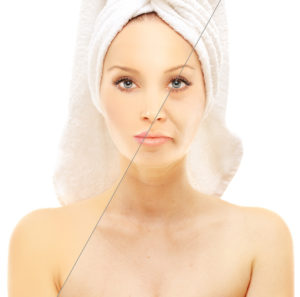
Fractional resurfacing improves sun damage, acne scarring, and other skin problems.
What is fractional resurfacing?
Fractional skin resurfacing is easy to understand conceptually if you compare it with turf aeration. That sounds coarse but stay with us. Lawn aeration devices make small punctures across the area of treatment. Untouched grass surrounds these punctures. Through the aeration holes, the lawn can receive more air down to the roots, plus fertilizers and water penetrate better. Finally, the holes encourage new roots to develop and deepen to heal the surface holes.
Fractional skin resurfacing has a similar concept. The Pixel laser is passed over the treatment area. It penetrates the epidermis (outer) layer of the patient’s skin and slightly penetrates down into the dermis, the skin’s second layer. The laser creates thousands of microscopic holes/channels down into the skin. Each channel is surrounded by untouched skin that immediately gets down to the business of healing the adjacent holes. In reality, the thousands of tiny punctures fully heal in just a few hours.
But what happens is the laser energy that has entered the dermis has two effects. First, the tiny punctures are still punctures, and the body responds with a wound-healing mechanism. Second, the heat energy in the dermis also tricks the body into thinking it has been wounded. The wound response is to immediately start building new skin cells and, more importantly, to produce and rush new collagen to the “wound” site. Since collagen is the protein in the skin responsible for creating a structural support framework, this new production of collagen firms and rejuvenates the skin.
What does fractional resurfacing help with?
At Dr. Lipton’s, we use Pixel fractional resurfacing to treat areas of sun damage, fine lines, uneven pigmentation, acne scars, areas with uneven textures, and enlarged pores. The procedure also makes the collagen remodeling, which has a tightening effect on the skin of the face, neck, and hands.
How many Pixel treatments will I need?
Most patients notice a significant improvement after their first Pixel treatment. Plus, as the collagen continues to build, improvements continue to build with it for up to six months after your session. To achieve the results desired, most patients seem to feel that from two to five treatments is best.
Interested in Pixel resurfacing with Dr. Lipton? Call us at 972-420-0023 to make your appointment.

